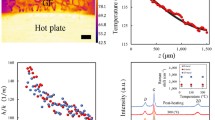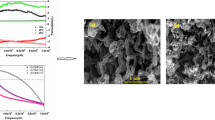Abstract
Three-dimensional graphene foams (GFs) benefit from a large surface area and unique physical properties. We present here the first-ever miniaturized GF-based resonators. We developed a simple yet reliable fabrication process, in which GFs are synthesized and assembled on a cavity to form suspended GF devices. We electrostatically excited these devices and analyzed their resonance and ring-down responses. We observed significant energy dissipation, as the quality factor of the devices was in the order of several tens. Additionally, we investigated the influence of temperature on the operation of the devices and found that high temperatures mechanically soften the resonators but also considerably enhance energy dissipation. Finally, our devices demonstrated a mode-coupling of a resonance mode and a mode having twice its frequency. Thus, this work paves the way toward the development of novel GF resonators that could be integrated into future devices, such as GF-based nano-electromechanical sensors, electrical circuits, and oscillators.

Similar content being viewed by others
References
Reddy, S. K.; Ferry, D. B.; Misra, A. Highly compressible behavior of polymer mediated three-dimensional network of graphene foam. RSC Adv. 2014, 4, 50074–50080.
Pettes, M. T.; Ji, H. X.; Ruoff, R. S.; Shi, L. Thermal transport in three-dimensional foam architectures of few-layer graphene and ultrathin graphite. Nano Lett. 2012, 12, 2959–2964.
Ren, H. Y.; Tang, M.; Guan, B. L.; Wang, K. X.; Yang, J. W.; Wang, F. F.; Wang, M. Z.; Shan, J. Y.; Chen, Z. L.; Wei, D. et al. Hierarchical graphene foam for efficient omnidirectional solar-thermal energy conversion. Adv. Mater. 2017, 29, 1702590.
Brownson, D. A. C.; Figueiredo-Filho, L. C. S.; Ji, X. B.; Gómez-Mingot, M.; Iniesta, J.; Fatibello-Filho, O.; Kampouris, D. K.; Banks, C. E. Freestanding three-dimensional graphene foam gives rise to beneficial electrochemical signatures within non-aqueous media. J. Mater. Chem. A 2013, 1, 5962–5972.
Samad, Y. A.; Li, Y. Q.; Alhassan, S. M.; Liao, K. Novel graphene foam composite with adjustable sensitivity for sensor applications. ACS Appl. Mater. Interfaces 2015, 7, 9195–9202.
Xu, R.; Zhang, H.; Cai, Y.; Ruan, J.; Qu, K.; Liu, E.; Ni, X.;. Lu, M.; Dong, X., Flexible and wearable 3D graphene sensor with 141 KHz frequency signal response capability. Appl. Phys. Lett. 2017, 111, 103501.
Xu, R. Q.; Lu, Y. Q.; Jiang, C. H.; Chen, J.; Mao, P.; Gao, G. H.; Zhang, L. B.; Shan, W. Facile fabrication of three-dimensional graphene foam/poly (dimethylsiloxane) composites and their potential application as strain sensor. ACS Appl. Mater. Interfaces 2014, 6, 13455–13460.
Chen, Z. P.; Xu, C.; Ma, C. Q.; Ren, W. C.; Cheng, H. M. Lightweight and flexible graphene foam composites for high-performance electromagnetic interference shielding. Adv. Mater. 2013, 25, 1296–1300.
Cohen, Y.; Reddy, S. K.; Ya’akobovitz, A. Heat dissipation in graphene foams. Nano Res. 2021, 14, 829–833.
Reddy, S. K.; Ya’akobovitz, A. Electromechanical behavior of graphene foams. Appl. Phys. Lett. 2019, 115, 211902.
Ya’akobovitz, A.; Krylov, S. The influence of perforation on electrostatic and damping forces in thick SOI MEMS structures. J. Micromech. Microeng. 2012, 22, 115006.
Kon, S.; Horowitz, R. A high-resolution MEMS piezoelectric strain sensor for structural vibration detection. IEEE Sens. J. 2008, 8, 2027–2035.
Ben-Shimon, Y.; Ya’akobovitz, A. Magnetic excitation and dissipation of multilayer two-dimensional resonators. Appl. Phys. Lett. 2021, 118, 063103.
Li, M.; Tang, H. X.; Roukes, M. L. Ultra-sensitive NEMS-based cantilevers for sensing, scanned probe and very high-frequency applications. Nat. Nanotechnol. 2007, 2, 114–120.
van Beek, J. T. M.; Puers, R. A review of MEMS oscillators for frequency reference and timing applications. J. Micromech. Microeng. 2011, 22, 013001.
Halevy, O.; Krakover, N.; Krylov, S. Feasibility study of a resonant accelerometer with bistable electrostatically actuated cantilever as a sensing element. Int. J. Non.-Linear. Mech. 2020, 118, 103255.
Ilyas, S.; Younis, M. I. Resonator-based M/NEMS logic devices: Review of recent advances. Sens. Actuators A: Phys. 2020, 302, 111821.
Ya’akobovitz, A.; Krylov, S.; Shacham-Diamand, Y. Large angle SOI tilting actuator with integrated motion transformer and amplifier. Sens. Actuators A: Phys. 2008, 148, 422–436.
Hafiz, M. A. A.; Kosuru, L.; Hajjaj, A. Z.; Younis, M. I. Highly tunable narrow bandpass MEMS filter. IEEE Trans. Electron Devices 2017, 64, 3392–3398.
Kim, S. J.; Park, J. Y.; Lee, S. H.; Yi, S. H. Humidity sensors using porous silicon layer with mesa structure. J..Phys. D: Appl. Phys. 2000, 33, 1781–1784.
Ding, Y.; Liu, Z.; Liu, L.; Li, Z. A surface micromachining process for suspended RF-MEMS applications using porous silicon. Microsyst. Technol. 2003, 9, 470–473.
Seals, L.; Gole, J. L.; Tse, L. A.; Hesketh, P. J. Rapid, reversible, sensitive porous silicon gas sensor. J. Appl. Phys. 2002, 91, 2519–2523.
Shtenberg, G.; Massad-Ivanir, N.; Fruk, L.; Segal, E. Nanostructured porous Si optical biosensors: Effect of thermal oxidation on their performance and properties. ACS Appl. Mater. Interfaces 2014, 6, 16049–16055.
Lammel, G.; Schweizer, S.; Schiesser, S.; Renaud, P. Tunable optical filter of porous silicon as key component for a MEMS spectrometer. J. Microelectromech. Syst. 2002, 11, 815–827.
Xue, Y. M.; Dai, P. C.; Zhou, M.; Wang, X.; Pakdel, A.; Zhang, Q. H.; Takei, T.; Fu, X. W.; Popov, Z. I. et al. Multifunctional superelastic foam-like boron nitride nanotubular cellular-network architectures. ACS Nano, 2017, 11, 558–568.
Meirovitch, L. Elements of Vibration Analysis; 2nd ed. McGraw-Hill: New York, 1986.
Hu, K. M.; Bo, P.; Li, X. Y.; Xin, Y. H.; Bai, X. R.; Li, L.; Zhang, W. M. Resonant nano-electromechanical systems from 2D materials. EPL. 2020, 131, 58001.
Lifshitz, R.; Roukes, M. L. Thermoelastic damping in micro- and nanomechanical systems. Phys. Rev. B 2008, 61, 5600–5609.
Srikar, V. T.; Senturia, S. D. Thermoelastic damping in fine-grained polysilicon flexural beam resonators. J. Microelectromech. Syst. 2002, 11, 499–504.
Yasumura, K. Y.; Stowe, T. D.; Chow, E. M.; Pfafman, T.; Kenny, T. W.; Stipe, B. C.; Rugar, D. Quality factors in micron- and submicron-thick cantilevers. J. Microelectromech. Syst. 2000, 9, 117–125.
Ko, J. H.; Jeong, J.; Choi, J.; Cho, M. Quality factor in clamping loss of nanocantilever resonators. Appl. Phys. Lett. 2011, 98, 171909.
Duwel, A.; Gorman, J.; Weinstein, M.; Borenstein, J.; Ward, P. Experimental study of thermoelastic damping in MEMS gyros. Sens. Actuators A: Phys. 2003, 103, 70–75.
Cohen, Y.; Reddy, S. K.; Ben-shimon, Y.; Ya’akobovitz, A. Height and morphology dependent heat dissipation of vertically aligned carbon nanotubes. Nanotechnology 2019, 30, 505705.
Chitara, B.; Ya’akobovitz, A. High-frequency electromechanical resonators based on thin GaTe. Nanotechnology 2017, 28, 42LT02.
Author information
Authors and Affiliations
Corresponding author
Rights and permissions
About this article
Cite this article
Ben-Shimon, Y., Reddy, S.K. & Ya’akobovitz, A. Graphene foam resonators: Fabrication and characterization. Nano Res. 15, 225–229 (2022). https://doi.org/10.1007/s12274-021-3463-3
Received:
Revised:
Accepted:
Published:
Issue Date:
DOI: https://doi.org/10.1007/s12274-021-3463-3




